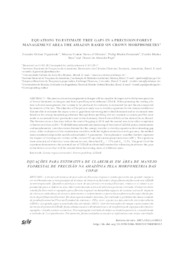Equations to estimate tree gaps in a precision forest management area the Amazon based on crown morphometry.
Equations to estimate tree gaps in a precision forest management area the Amazon based on crown morphometry.
Autoria: FIGUEIREDO, E. O.; OLIVEIRA, M. V. N. d'; FEARNSIDE, P. M.; BRAZ, E. M.; PAPA, D. de A.
Resumo: The precision forest management technique still has much to be improved with the incorporation of forest biometric techniques and forest profiling with airborne LIDAR. When planning the cutting of a tree in forest management, the volume to be produced for industry is estimated but not the area impacted by removal of the tree. The objective of the present study was to develop equations for the Amazon rainforest that are able to estimate the impact area of gaps from harvesting individual dominant and co-dominant trees based on the canopy morphology obtained through forest profiling. On two separate occasions profiles were made in an annual forest-production unit in the Antimary State Forest (FEA) in the state of Acre, Brazil. The first was done a few days before the start of logging in 2010 and the second was done after completion of harvest activities in 2011. With field measurements and processing of the cloud of LIDAR points, dendrometric and morphometric variables were obtained for the canopy in order to develop equations for estimating gap areas. After evaluation of the explanatory variables with the highest correlation with gap area, the method used considered all possible models and included 2-4 parameters. The explanatory variables that best represent the impact of clearings are volume of the crown (VCop) and crown-projection area (APC). Ten equations were selected, of which two were chosen for use; these had R2 aj > 75% and Syx <23%. The good fit of the equations demonstrates the potential use of LIDAR to obtain information for estimating in advance the gaps in the forest cover that will be created from harvesting trees of different sizes.
Ano de publicação: 2017
Tipo de publicação: Artigo de periódico
Unidade: Embrapa Florestas
Palavras-chave: Acre, Administração florestal, Amazonia Occidental, Amazônia Ocidental, Análise estatística, Análisis de regresión, Análisis estadístico, Biometria, Biometry, Bosques tropicales, Bujari (AC), Canopy gaps, Clareira, Copa, Copa de los árboles, Espacios vacíos en el dosel, Floresta Estadual do Antimary (AC), Floresta tropical, Forest management, Lidar, Lásers, Manejo de precisão, Manejo forestal, Morfometría, Morphometry, Perfilamento florestal, Raio laser, Regression analysis, Regressão linear, Sena Madureira (AC), Statistical analysis, Tree crown, Tropical forests, Western Amazon
Observações
1 - Por padrão são exibidas publicações dos últimos 20 anos. Para encontrar publicações mais antigas, configure o filtro ano de publicação, colocando o ano a partir do qual você deseja encontrar publicações. O filtro está na coluna da esquerda na busca acima.
2 - Para ler algumas publicações da Embrapa (apenas as que estão em formato ePub), é necessário ter, no celular ou computador, um desses softwares gratuitos. Sistemas Android: Google Play Livros; IOS: iBooks; Windows e Linux: software Calibre.
Acesse outras publicações
Acesse a Base de Dados da Pesquisa Agropecuária (BDPA) para consultar o acervo completo das bibliotecas da Embrapa.

